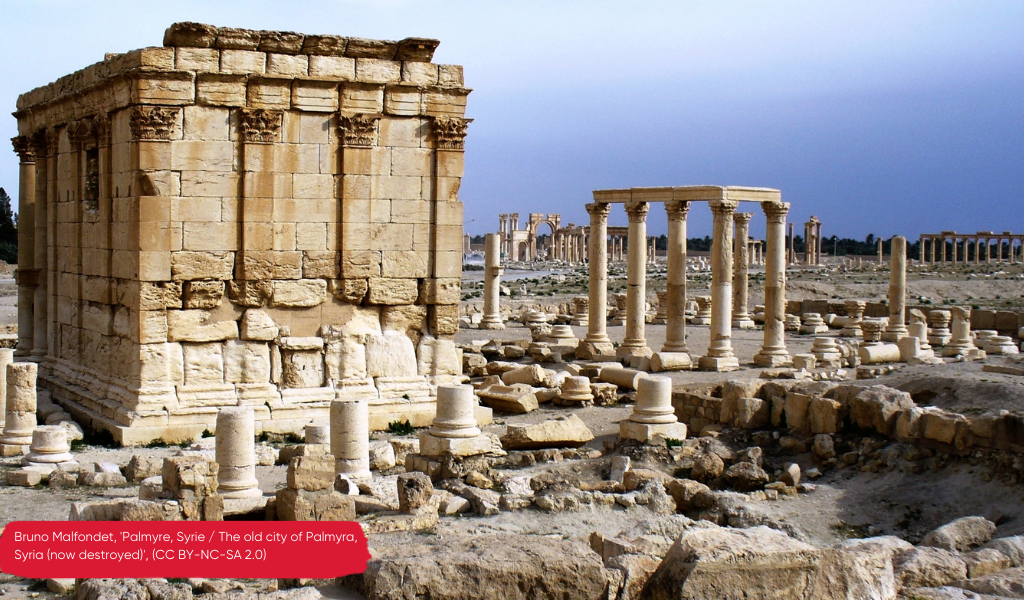Heritage destruction, and the ideological motivations behind it, is vital for understanding conflict as well as addressing questions on what heritage is documented, preserved and rebuilt. In the first of two blogs on Daesh’s heritage destruction in Iraq and Syria, Sofya Shahab describes the historical phenomenon of heritage destruction, and why this form of place-based violence was a deliberate tactic for attacking their enemies and establishing territorial control.

The value of cultural and religious heritage in shaping identities and communities has meant that, throughout history, the construction and destruction of monuments have been used to exert power and control over peoples and territories. Archaeological records dating back to the Near Eastern Iron Age describe how statues of rulers would be defaced as a means of denying and resisting both the statues’ and the rulers’ power.
More recently, during the conflict in Bosnia from 1992-1995, Mostar’s historic 16th century bridge was deliberately shelled by Croat forces, while in 2012 the Salafi jihadist group, Ansar Dine, destroyed mausoleums and tombs in the Old City of Timbuktu, which had been declared a World Heritage Site in 1988.
However, the rise of Daesh and the establishment of the self-proclaimed Islamic Caliphate across Iraq and Syria in 2014 heralded a new wave of heritage destruction as an act of intentional violence during conflict. In Syria alone, Daesh destroyed Shiite shrines in the Ammar bin Yasir Mosque in Raqqa, the 4th century Mar (Saint) Elian Christian Monastery and perhaps most famously the ancient city of Palmyra. Archaeological remains such as the Dura-Europos – a Hellenistic city located on the Euphrates – were also systematically looted as a means of financing their campaign, while untold numbers of churches and shrines have been desecrated by the group.
It’s important to stress that the strategic campaign against the diverse heritage of Syria and Iraq was deliberate, and not an act of spontaneous vandalism or irrational hatred.
What were the motivations behind the heritage violence carried out by Daesh and why is it important to understand them?
The destruction of religious and archaeological heritage in Syria, as well as the publicity these acts attracted, enabled Daesh to quickly establish their ideology, identity, and sovereignty, so that in broadcasting their violence against heritage (on social media, for example), Daesh were able to inflict psychological, emotional and physiological harm on those they opposed and build their power over and beyond the physical territories they controlled.
Through heritage destruction, Daesh established their ideology by engaging in religious and political iconoclasm or idol breaking. They presented this destruction as a means of ridding society of what they deemed to be ‘idolatry’, the veneration of archaeological heritage within western frameworks of value and religious spaces, and icons that opposed their vision for a socially homogenous caliphate that did not accept any deviance from Shariah law.
Iconoclasm has a long-history and has been used in the reformulation of society. For example the Reformation movement in 16th century Europe challenged the substantial religious and political authority of the Catholic Church (as well as its significant wealth), and resulted in the largescale physical destruction of religious artefacts and buildings.
Using their propaganda outlets and social media, Daesh enacted their sovereignty and displayed ideological and territorial control by violating accepted international conventions for heritage (e.g. the Geneva Convention). Heritage destruction deployed by Daesh enhanced both local and international perceptions of their power and also represented a deliberate attack against their enemies as these religious and archaeological sites were considered sacred.
In wiping heritage from the landscape, Daesh were equally erasing the identities connected to those landscapes. While heritage sites provide physical spaces where national and religious identities can be performed, in the anthropological sense, they also go further than that, contributing directly to those identities by providing tangible markers that cement belonging and enable cultural practices and rituals that create and embody community. This meant that an element of what Daesh achieved was a place-based violence that annihilated any sense of belonging, where belonging is tied to history and represented through tangible structures and the memories held within them. As a result, Daesh engaged in practices of exclusion and expulsion to create physical and existential displacements among targeted religious groups.
By understanding these motivations for the heritage destruction undertaken by Daesh in Syria and Iraq, we can begin to gain further understanding of the importance of heritage and the role it plays in political conflicts. This is particularly necessary when it comes to questions around what heritage is documented, preserved and rebuilt, and how this may be done. A matter we return to in the next Coalition for Religious Equality and Inclusive Development (CREID) heritage blog.
In Part 2 of this blog, I will look in more detail at the impacts of heritage destruction on communities in Syria and approaches to protection and preservation.
